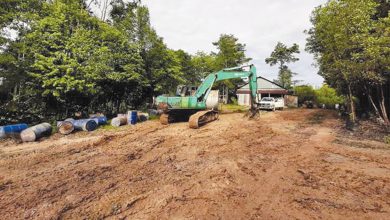Ruth: “Ipoh is very special”
By Mariam Mokhtar
The word Iversen is a household name again, just as it was in the 1950s and 60s, but for completely different reasons.
In post war Malaya, Berthel Michael Iversen rose to prominence, as the Danish architect who helped rebuild war-torn Malaya, with prefabricated houses, and grand buildings throughout Malaya and Singapore, many of which remain to this day.
Last month, his daughter, Ruth Iversen Rollit, embarked on a tour to launch the book ‘Iversen: Architect of Ipoh and Modern Malaya’. Her book tour covered Penang, Ipoh and Kuala Lumpur, finishing in London, where Ruth resides.
In London, the launch was hosted by the eminent British architect, Sir Terry Farrell. The guests were mostly people who treasured Malaysia’s heritage and culture. Malaysia’s foremost harpsichordist, the Oxford based Dr. Ng Kah-Ming was present, as was Dr. Annabel Teh Gallop, the curator for South East Asian Studies at the British Library, along with many Ipohites and Penang grandees, as well as representatives from The New Straits Times and TV3.
They came, to listen to Ruth, and her publisher, Khoo Salma Nasution from ARECA books, talk about the heritage of Malaysia, and the challenges they face in its preservation.
When The Ipoh Echo caught up with her, in London, a jubilant Ruth said, “I feel so much joy and pride in knowing that people would get to know or remember my father who had done so much for Malaya and Malaysia. Pride that I had achieved my long dream, and gratitude to Salma, my publisher and her wonderful team.”
Iversen the book, had taken 6 years to come to fruition. She said, “I spent a lot of time locked away in the top room of my house, and enjoyed every minute of it, and hope that I behaved just like normal.”
Despite a grueling three week tour of Malaysia for the Malaysian chapter of the launch, each city threw up a different experience.
“Penang was the first, and so exciting. I knew many of the people there.
“Ipoh was very special, being my hometown with many old friends and held in a most wonderful venue: The Sarang Paloh Event Hall, a beautifully restored OCBC Bank in Hugh Low Street. It is also a newly opened hotel and restored to perfection.
“KL was magical and the launch was at the Residence of the British High Commissioner. Her Excellency Vicki Treadell, is an Ipoh girl. Her father Rex Jansz was at Grenier’s in Station Road, the same street my father had his office.”
Ruth shared her personal ties with the High Commissioner; “Vicki’s mother was Chinese and a great seamstress. She made my wedding dress in 1962. Vicki went to school in UK and joined the Foreign Office. Her first posting as a 21-year-old girl was to the British Embassy*, in Pakistan where she worked in my husband Philip’s huge Immigration Section.
“When we met, I wrote to her parents, and promised them I would look after their young daughter, whom I had known since she was three years-old.”
Ruth described why the British High Commissioner had hosted her KL launch, “After she met the chairman of the British Malaysian Society (UK), when he visited KL, Vicki wrote to me and offered to launch Iversen at her residence.”
Ruth said, “In Penang I met three of my father’s apprentices from the 60’s. I met the architect who had taken over his business when the firm closed, in Penang. I met people who live in Iversen houses and who love their homes.
“I met so many people I knew before, that it was like coming home. I cannot remember all the names, but it was overwhelming and a total joy.
“In Ipoh the people who remembered him and had met him, like William Toh’s father and the Yee family, came.
“In KL, I met Ahmad Merican, formerly of Radio Malaya, in Federal House when it was first built. I met many old friends there, like Valerie Albakri, architects Ken Yeang and Lim Take Bane, the number two from the Danish embassy and some friends who had flown in from Bangkok and Singapore.”
Iversen painted many landscapes, some of which hang in Ruth’s London residence. Her favourite is the one of 110 Tambun Road, her former home. She expressed sadness that the Ipoh of today is filthy, unlike the Ipoh of her youth.
Her poignant message to Ipohites was; “Treasure the wonderful heritage of your city, and do not demolish your past. Tourism is the largest industry, but tourists do not want to come and look at a town that is a poor imitation of Shanghai, Chicago or any other place on earth.”
When asked if she had plans for a second book, Ruth was emphatic, “No! I am too old and still have so many other things to do.”
Proud that her father will be remembered as one of the pillars of modern Malaya/Malaysia, and thankful that her labour of love is accomplished, she described the day of publication, “After a long flight from London, I went to bed with a huge smile on my lips.”
(*When Pakistan left the Commonwealth)


